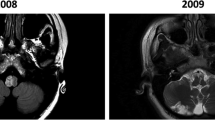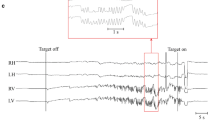Abstract
Monocular torsional eye oscillations are a rare form of disconjugate nystagmus and the underlying pathophysiology is not well understood. Here, we present and discuss a case with disabling torsional oscillopsia in one eye only. The patient exhibited (i) spontaneous pendular torsional nystagmus of the left eye and (ii) rhythmic involuntary movements of the soft palate and uvula, consistent with the syndrome of oculopalatal tremor with monocular nystagmus. Brain MRI revealed an infarct of the left dentate nucleus in the cerebellum and, more caudally, a secondary hypertrophic degeneration of the right inferior olivary nucleus. To account for the presence of torsional nystagmus on the eye contralateral to the side of inferior olivary hypertrophy and ipsilateral to the lesioned dentate nucleus, we discuss the hypothesis of a (inferior olivary nucleus-mediated) malfunctioning adaptation of the anterior canal vestibulo-ocular reflex.


Similar content being viewed by others
Data Availability
The data that support the findings of this study are available from the corresponding author upon reasonable request.
References
Anagnostou E, Karathanasis D, Evangelopoulos ME. The Heimann-Bielschowsky phenomenon after optic neuritis. Mult Scler Relat Disord. 2022;58:103523.
Thurston ES, Saul RF. Superior oblique myokymia: quantitative description of the eye movement. Neurology. 1991;41:1679–81.
Yousry I, Dieterich M, Naidich TP, Schmid UD, Yousry TA. Superior oblique myokymia: magnetic resonance imaging support for the neurovascular compression hypothesis. Ann Neurol. 2002;51:361–8.
Shaikh AG, Hong S, Liao K, Tian J, Solomon D, Zee DS, Optican LRJ, LM. Oculopalatal tremor explained by a model of inferior olivary hypertrophy and cerebellar plasticity. Brain. 2010;133:923–40.
Tilikete C, Desestret V. Hypertrophic olivary degeneration and palatal or oculopalatal tremor. Front Neurol. 2017;8:302.
Kim JS, Moon SY, Choi KD, Kim JH, Sharpe JA. Patterns of ocular oscillation in oculopalatal tremor: imaging correlations. Neurology. 2007;68:1128–35.
Jang L, Borruat FX. Oculopalatal tremor: variations on a theme by Guillain and Mollaret. Eur Neurol. 2014;72:144–9.
Tempia F, Dieringer N, Strata P. Adaptation and habituation of the vestibulo-ocular reflex in intact and inferior olive-lesioned rats. Exp Brain Res. 1991;86:568–78.
Ito M, Sakurai M, Tongroach P. Climbing fiber induced depression of both mossy fiber responsiveness and glutamate sensitivity of cerebellar Purkinje cells. J Physiol. 1982;324:113–34.
Nakada T, Kwee IL. Oculopalatal myoclonus. Brain. 1986;109:431–41.
Ito M, Nisimaru N, Yamamoto M. Specific patterns of neuronal connexions involved in the control of the rabbit’s vestibulo-ocular reflexes by the cerebellar flocculus. J Physiol. 1977;265:833–54.
Author information
Authors and Affiliations
Contributions
E.A.: study conception and design, manuscript preparation.
S.G: study conception and design, manuscript preparation
G.A.: study conception and design, manuscript preparation.
A.Z.: study conception and design, final approval of manuscript.
G.V..: study conception and design, manuscript preparation.
Corresponding author
Ethics declarations
Ethical Approval
The study was performed in accordance with the ethical standards laid down in the Declaration of Helsinki (1964).
Informed Consent
The informed and written consent for publication of the data and videos was obtained from the patient.
Competing Interests
The authors declare that they have no conflict of interest.
Additional information
Publisher’s Note
Springer Nature remains neutral with regard to jurisdictional claims in published maps and institutional affiliations.
Supplementary Information
ESM 1
Rights and permissions
Springer Nature or its licensor (e.g. a society or other partner) holds exclusive rights to this article under a publishing agreement with the author(s) or other rightsholder(s); author self-archiving of the accepted manuscript version of this article is solely governed by the terms of such publishing agreement and applicable law.
About this article
Cite this article
Anagnostou, E., Gerakoulis, S., Armenis, G. et al. Monocular Torsional Oscillopsia in Dentato-olivary Disconnection. Cerebellum (2023). https://doi.org/10.1007/s12311-023-01626-1
Accepted:
Published:
DOI: https://doi.org/10.1007/s12311-023-01626-1




